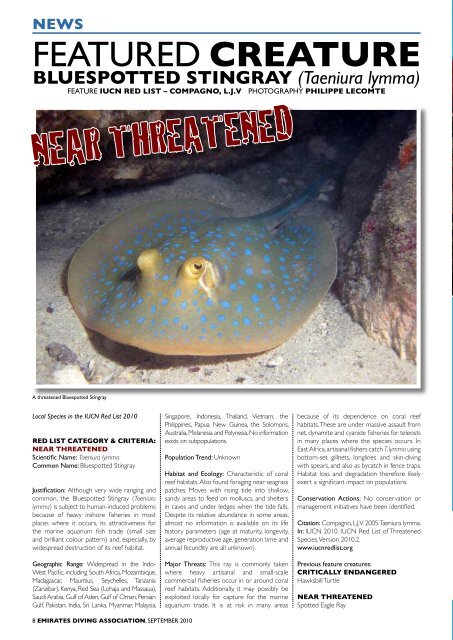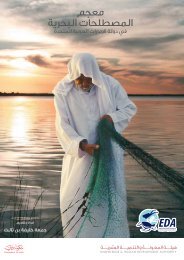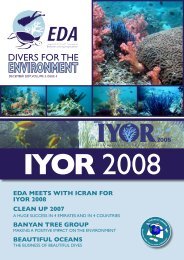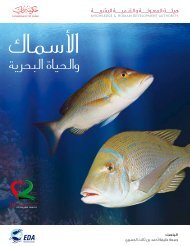NEWS - Emirates Diving Association
NEWS - Emirates Diving Association
NEWS - Emirates Diving Association
Create successful ePaper yourself
Turn your PDF publications into a flip-book with our unique Google optimized e-Paper software.
<strong>NEWS</strong><br />
FEATURED CREATURE<br />
BLUESPOTTED STINGRAY (Taeniura lymma)<br />
FEATURE IUCN RED LIST – COMPAGNO, L.J.V PHOTOGRAPHY PHILIPPE LECOMTE<br />
near threatened<br />
A threatened Bluespotted Stingray<br />
Local Species in the IUCN Red List 2010<br />
Red List Category & Criteria:<br />
NEAR THREATENED<br />
Scientific Name: Taeniura lymma<br />
Common Name: Bluespotted Stingray<br />
Justification: Although very wide ranging and<br />
common, the Bluespotted Stingray (Taeniura<br />
lymma) is subject to human-induced problems<br />
because of heavy inshore fisheries in most<br />
places where it occurs, its attractiveness for<br />
the marine aquarium fish trade (small size<br />
and brilliant colour pattern) and, especially, by<br />
widespread destruction of its reef habitat.<br />
Geographic Range: Widespread in the Indo-<br />
West Pacific, including South Africa, Mozambique,<br />
Madagascar, Mauritius, Seychelles, Tanzania<br />
(Zanzibar), Kenya, Red Sea (Lohaja and Massaua),<br />
Saudi Arabia, Gulf of Aden, Gulf of Oman, Persian<br />
Gulf, Pakistan, India, Sri Lanka, Myanmar, Malaysia,<br />
Singapore, Indonesia, Thailand, Vietnam, the<br />
Philippines, Papua New Guinea, the Solomons,<br />
Australia, Melanesia and Polynesia. No information<br />
exists on subpopulations.<br />
Population Trend: Unknown<br />
Habitat and Ecology: Characteristic of coral<br />
reef habitats. Also found foraging near seagrass<br />
patches. Moves with rising tide into shallow,<br />
sandy areas to feed on molluscs, and shelters<br />
in caves and under ledges when the tide falls.<br />
Despite its relative abundance in some areas,<br />
almost no information is available on its life<br />
history parameters (age at maturity, longevity,<br />
average reproductive age, generation time and<br />
annual fecundity are all unknown).<br />
Major Threats: This ray is commonly taken<br />
where heavy artisanal and small-scale<br />
commercial fisheries occur in or around coral<br />
reef habitats. Additionally, it may possibly be<br />
exploited locally for capture for the marine<br />
aquarium trade. It is at risk in many areas<br />
because of its dependence on coral reef<br />
habitats. These are under massive assault from<br />
net, dynamite and cyanide fisheries for teleosts<br />
in many places where the species occurs. In<br />
East Africa, artisanal fishers catch T. lymma using<br />
bottom-set gillnets, longlines and skin-diving<br />
with spears, and also as bycatch in fence traps.<br />
Habitat loss and degradation therefore likely<br />
exert a significant impact on populations.<br />
Conservation Actions: No conservation or<br />
management initiatives have been identified.<br />
Citation: Compagno, L.J.V. 2005. Taeniura lymma.<br />
In: IUCN 2010. IUCN Red List of Threatened<br />
Species. Version 2010.2.<br />
www.iucnredlist.org<br />
Previous feature creatures:<br />
Critically endangered<br />
Hawksbill Turtle<br />
Near Threatened<br />
Spotted Eagle Ray<br />
8 EMIRATES DIVING ASSOCIATION, SEPTEMBER 2010 SEPTEMBER 2010, EMIRATES DIVING ASSOCIATION 9












